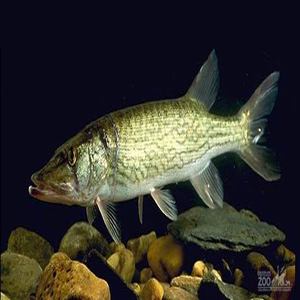 Grass pickerel have a elongated, oval body that is dark olive to black on top and a white belly.They have dark wavy lines on their sides with gray fins.It has a large mouth with well developed teeth. It can grow up to ten inches and weighs up to half a pound. It is a carnivorous fish. It is also called a grass pike, little pickerel, or the pickerel. The species is considered stable. Current threats include fishing, channelization, and riparian habitat removal.
Grass pickerel have a elongated, oval body that is dark olive to black on top and a white belly.They have dark wavy lines on their sides with gray fins.It has a large mouth with well developed teeth. It can grow up to ten inches and weighs up to half a pound. It is a carnivorous fish. It is also called a grass pike, little pickerel, or the pickerel. The species is considered stable. Current threats include fishing, channelization, and riparian habitat removal.
Location: Wolf Wilderness Lodge
Share:
Range
Grass Pickerel range is from eastern United States at the St. Lawrence River drainage to the Finger Lakes in Florida. They exist mainly west of the Appalachian mountain chain.
Habitat
The grass pickerel prefers sluggish habitat, such as pools of streams, weed beds along stream shores, or among fallen woody debris such as tree limbs; lowland areas, may be found in ditches and sloughs.
Conservation Status
Least Concern
Primary Threats
Gestation
8-15 days
Litter
186 – 542 eggs
Behavior
The grass pickerel is an ambush predator, darting out of vegetation to attack its prey. They are solitary and come together only to breed. It is not considered a sport fish because of its small size.
Reproduction
In the spring the pickerel migrates upstream to spawn. In shallow water the eggs are laid. They are yellow and are released over submerged vegetation. They are then abandoned as there is no defense for them or care provided. They are sexually mature around two years of age.
Wild Diet
Diet includes other fish, crayfish, aquatic insects and their larvae.
Zoo Diet

